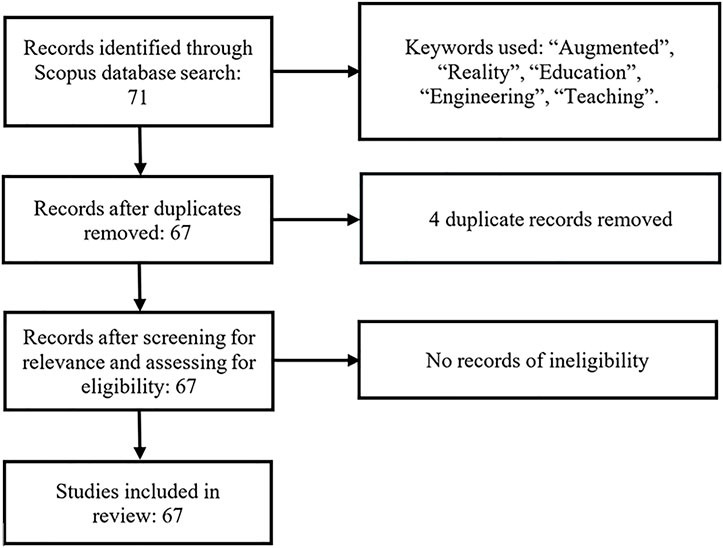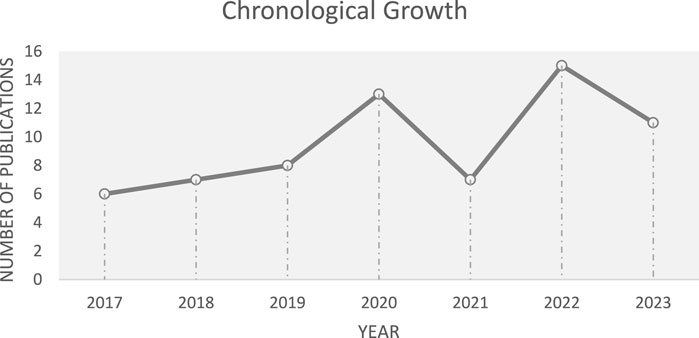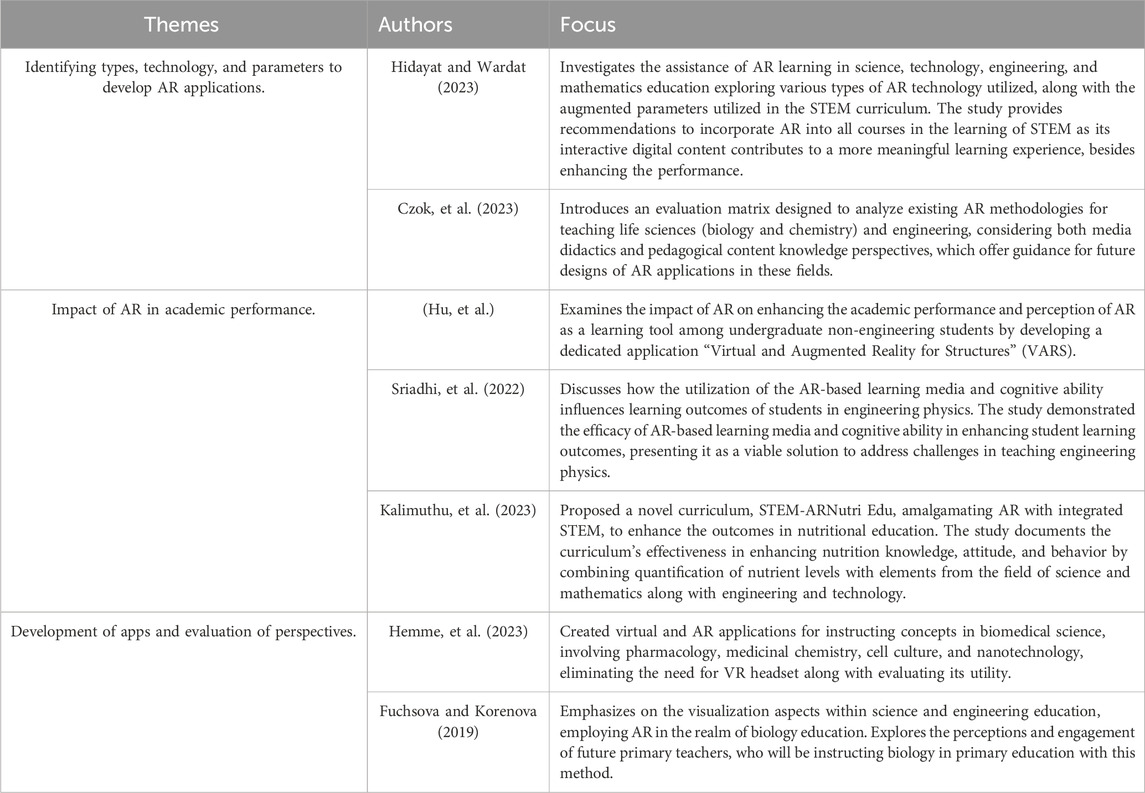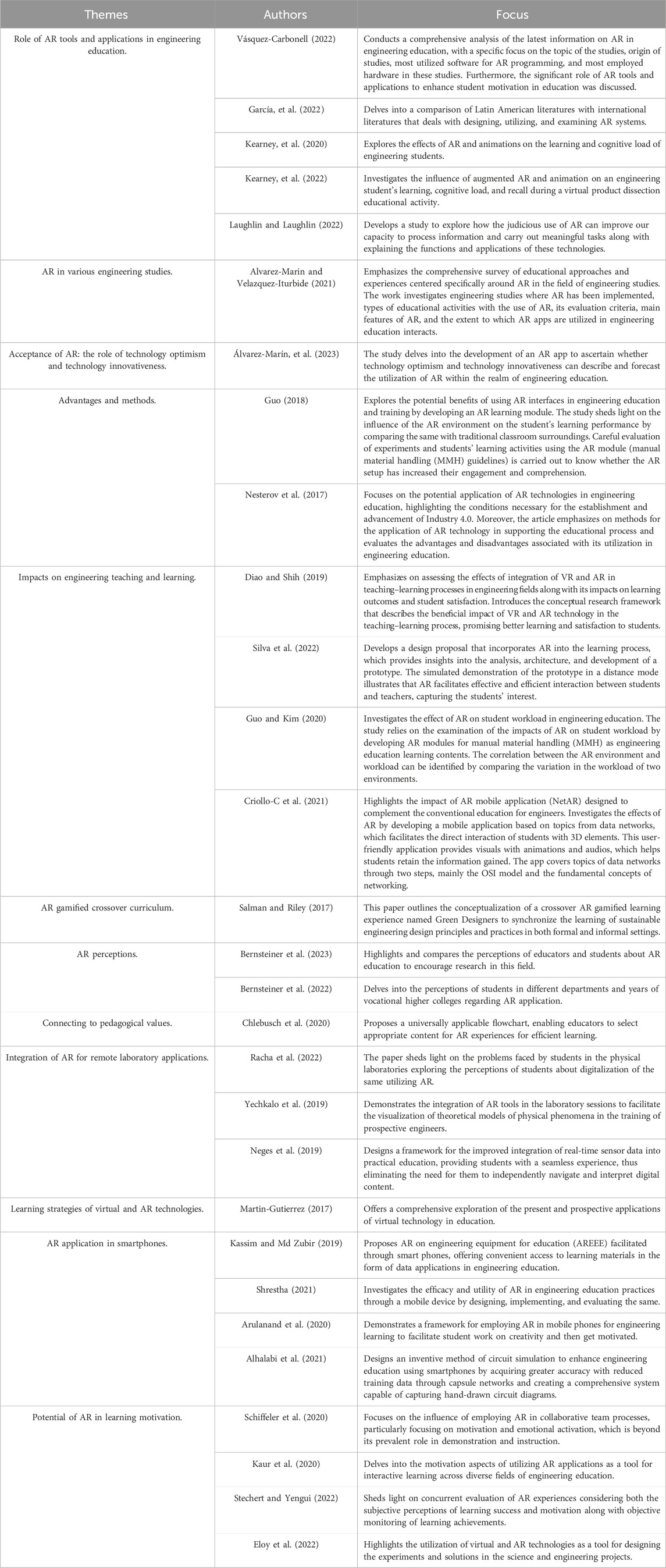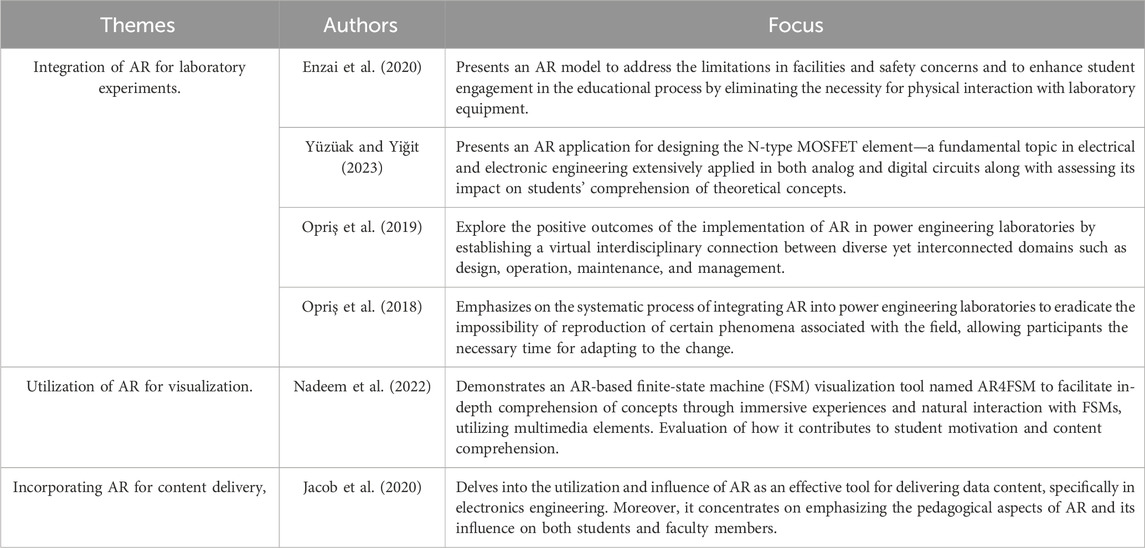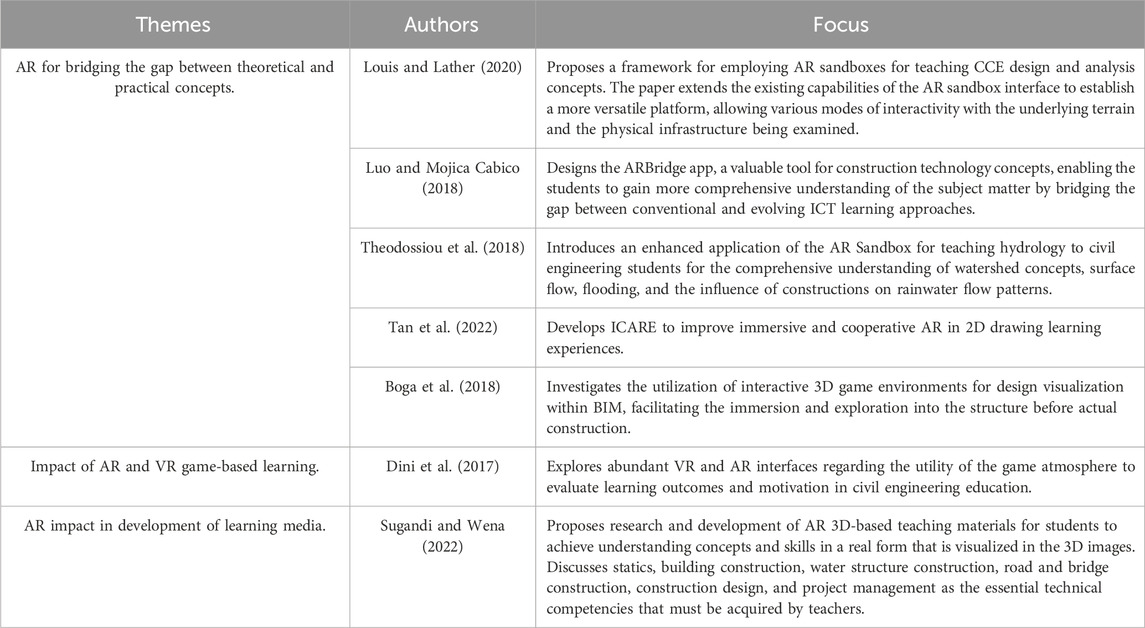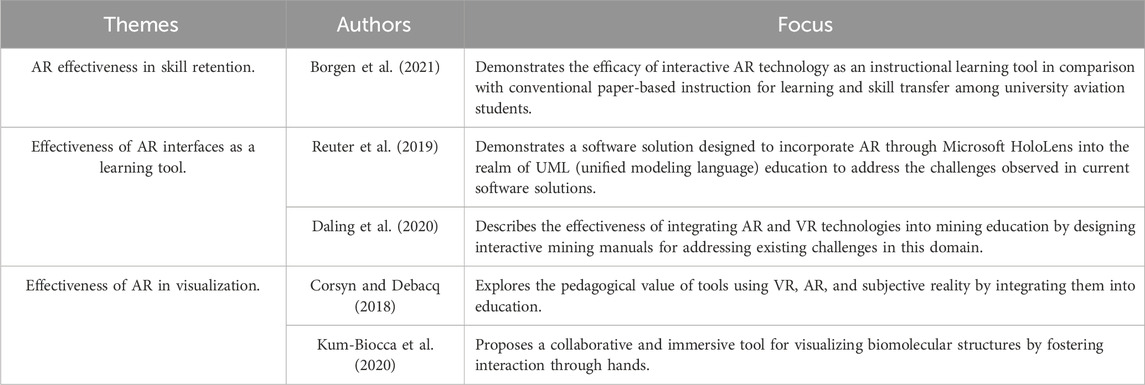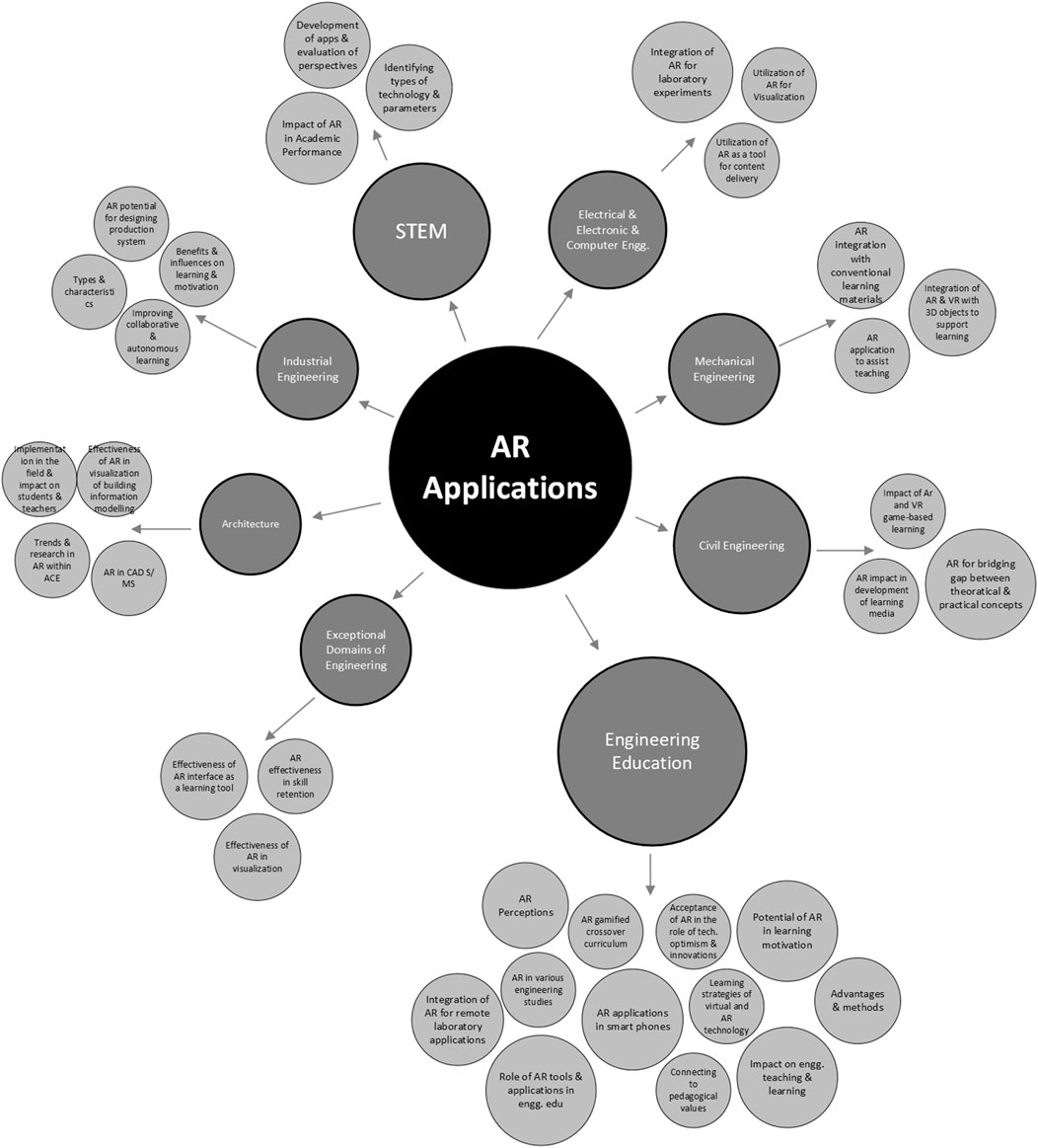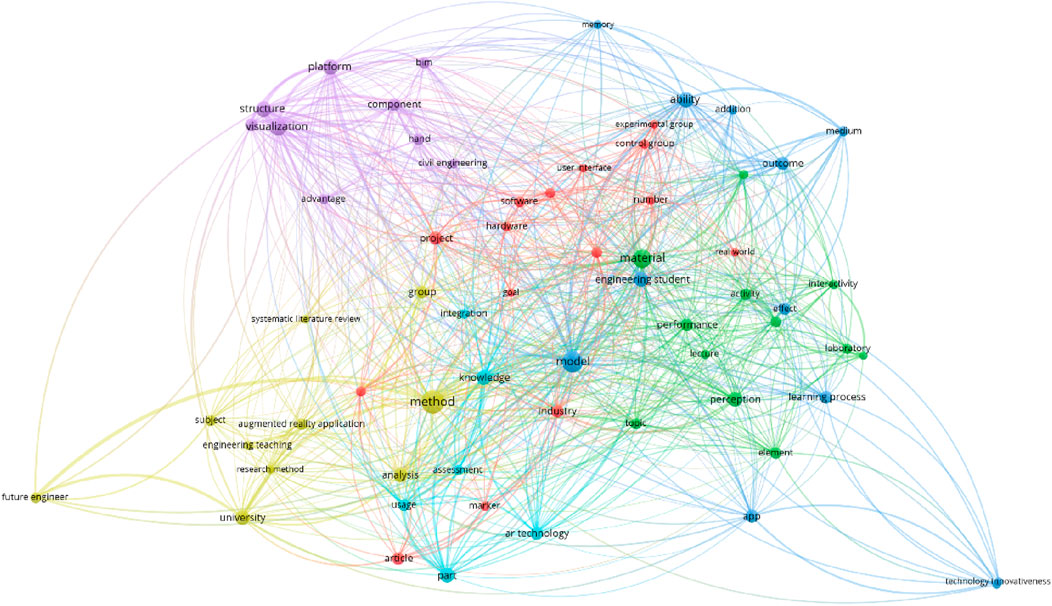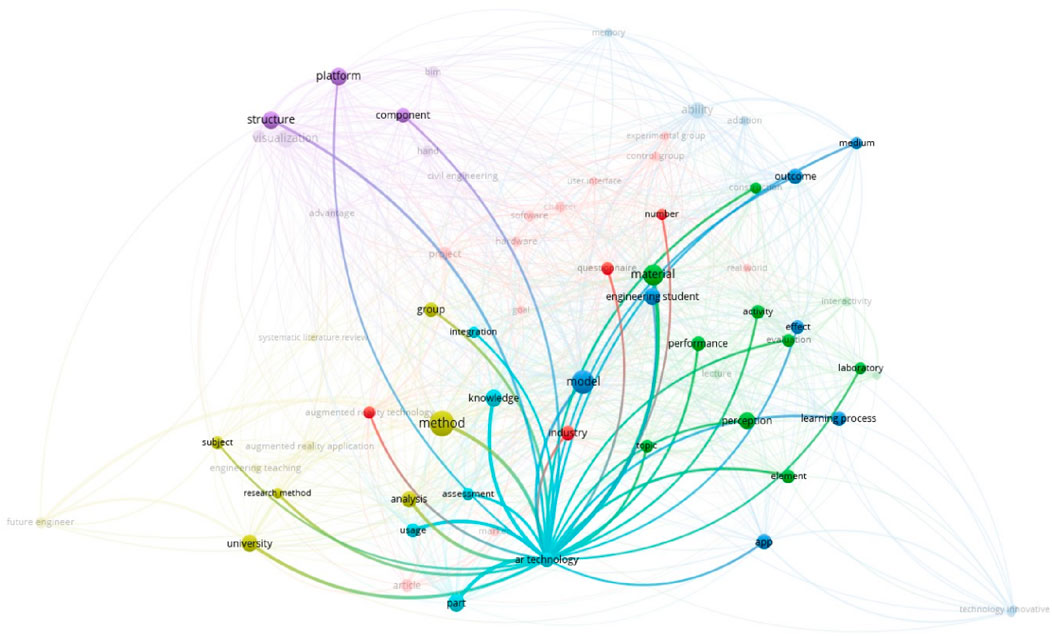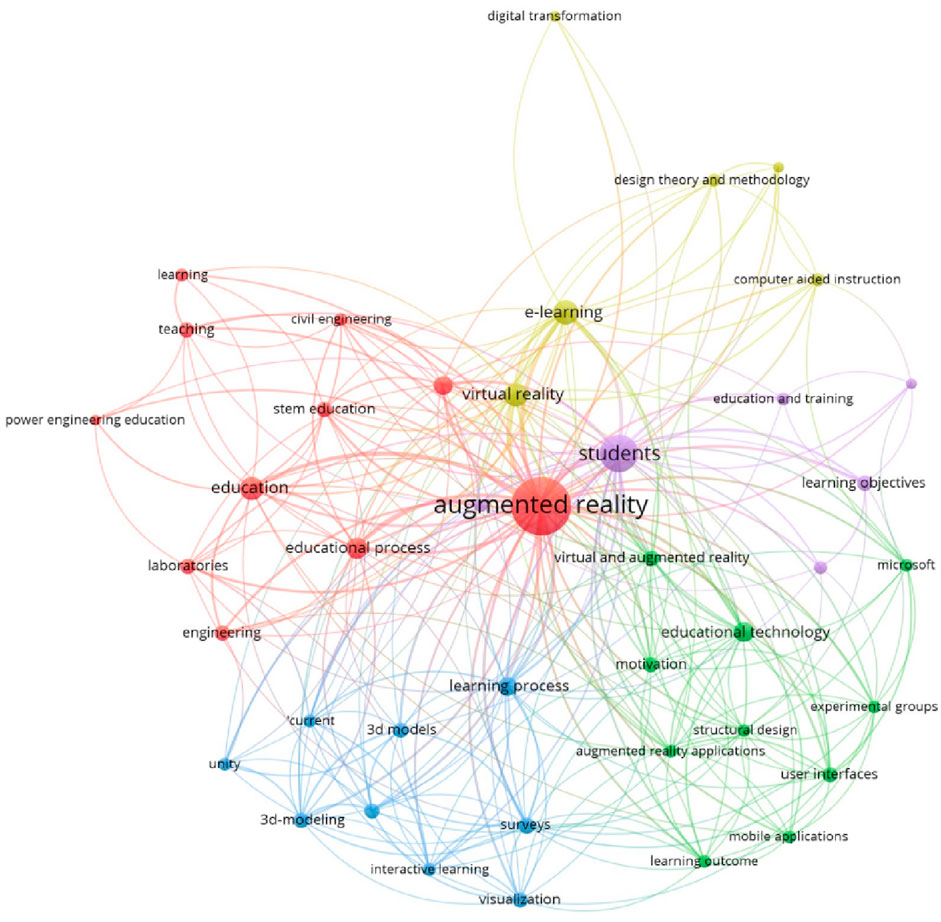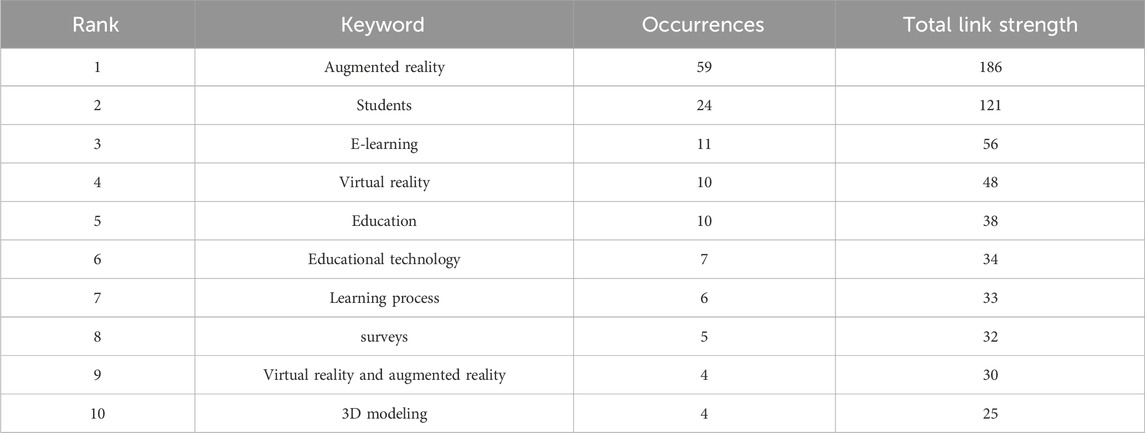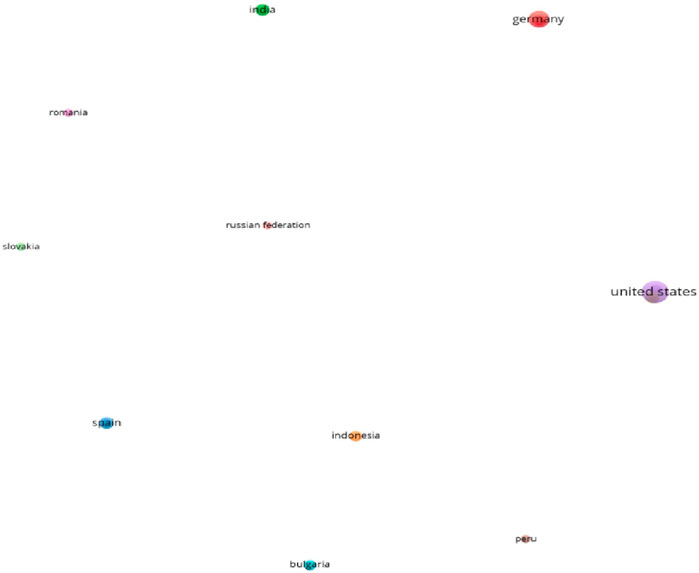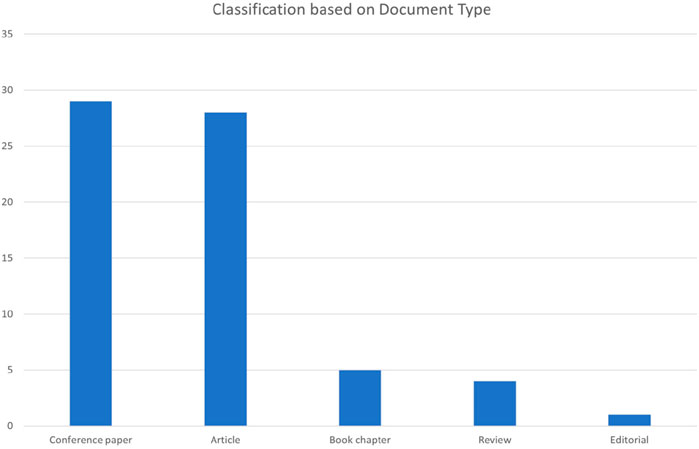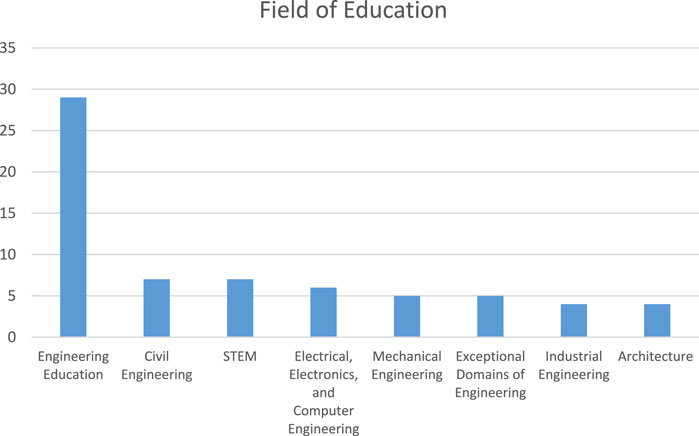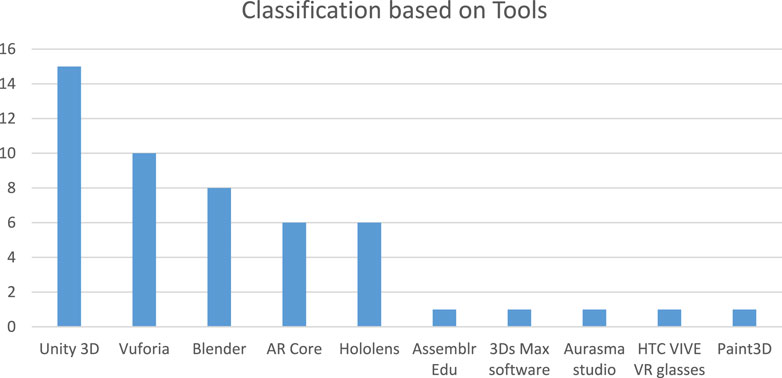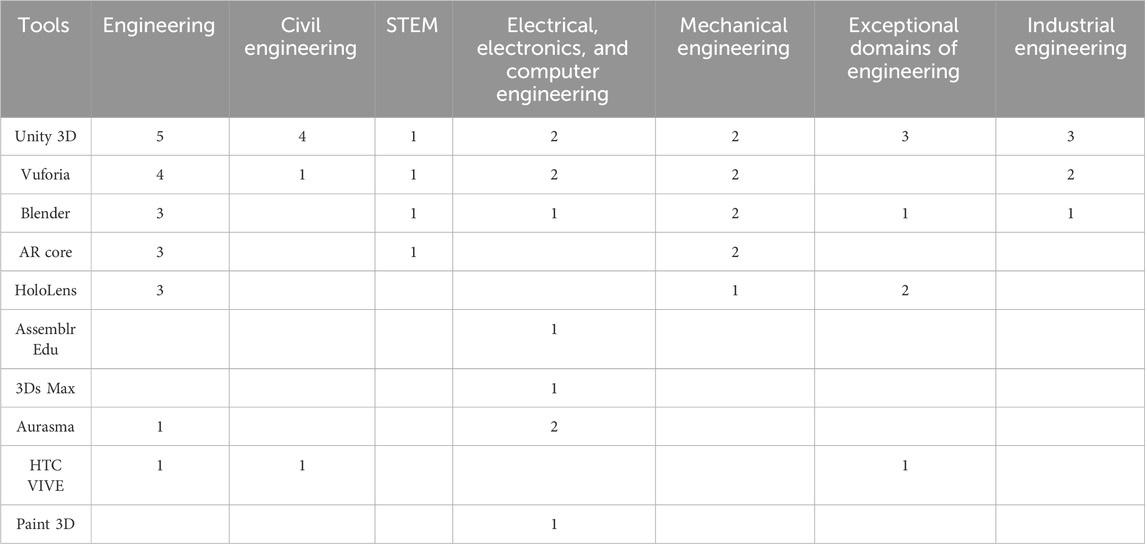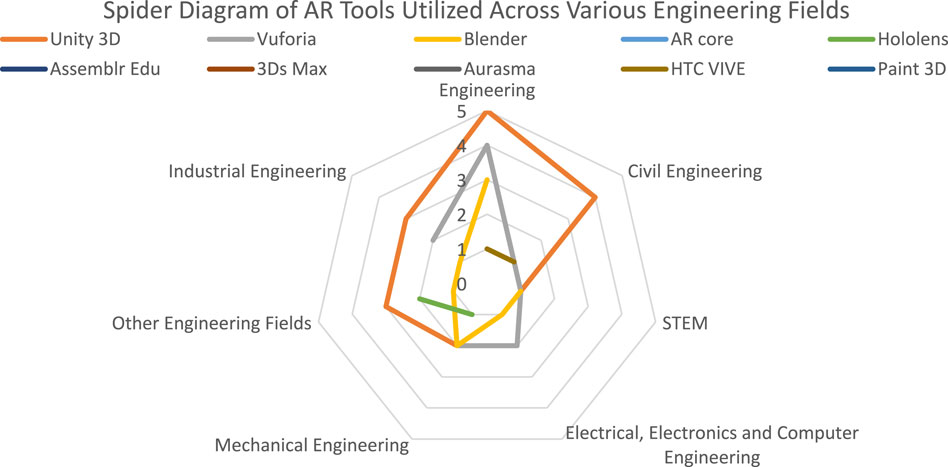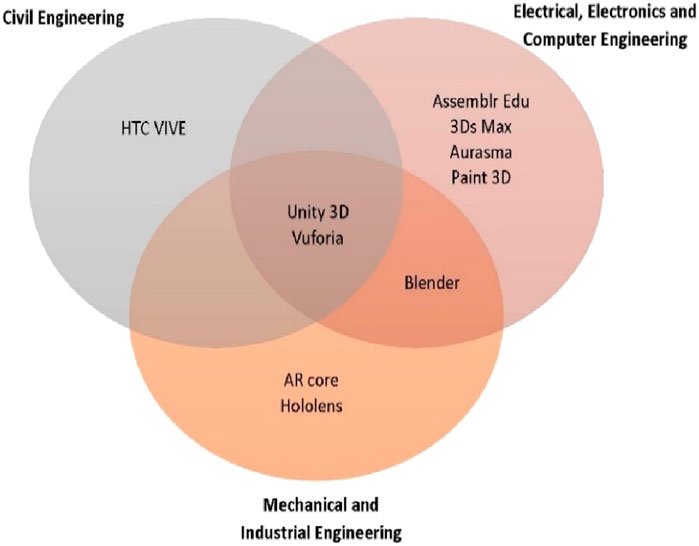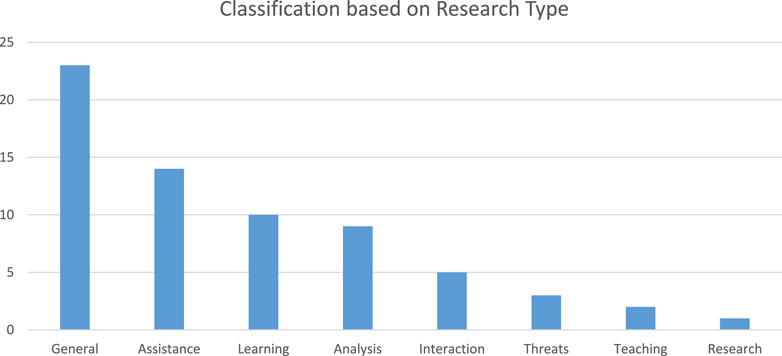- Department of Industrial Engineering, College of Engineering, American University of Sharjah, Sharjah, United Arab Emirates
Introduction: Augmented reality (AR) is a transformative technology that enhances teaching and learning by blending virtual and real environments. While the potential of AR to improve visualization, interaction, and student engagement in engineering education is recognized, its application across various engineering disciplines remains underexplored. This study systematically investigates the use of AR in engineering fields, highlighting its educational impact and identifying gaps for future research.
Methods: A systematic review was conducted using the Preferred Reporting Items for Systematic Reviews and Meta-Analyses (PRISMA) framework, analyzing 67 peer-reviewed papers on AR in engineering education. Content analysis was employed to assess AR’s effectiveness in enhancing visualization, interaction, and motivation. A bibliometric analysis identified key AR tools, research trends, geographic distribution, and interdisciplinary collaboration.
Results: AR is extensively applied in civil and mechanical engineering, where tools such as Unity 3D significantly improve visualization and interaction. AR enhances student engagement and comprehension, particularly in complex areas like construction design. However, its adoption in other engineering disciplines remains limited. The analysis also shows the positive impact of AR on motivation and learning outcomes despite challenges such as technical limitations and insufficient training for educators.
Conclusion: Although AR is gaining traction in engineering education, broader adoption is hindered by technical challenges and the need for better curriculum integration. Future research should address these barriers and explore AR’s potential in underutilized engineering disciplines to maximize its educational benefits.
1 Introduction
In today’s exciting era of the metaverse, augmented reality (AR) emerges as a transformative tool, reshaping our experiences and enhancing human–computer interactions. AR is extensively applied in both industrial and educational contexts, with engineering taking a forefront. This field extends beyond mere mechanization, aiming to alleviate societal burdens and enhance human welfare (Sheppard et al., 2007). Engineering education requires deep knowledge, problem-solving skills, and critical judgment, all geared toward achieving societal benefit. Exploring AR in engineering education opens up innovative avenues for visualization and creative thinking. Understanding virtual reality (VR) is pivotal as it relates to AR; VR immerses users in artificial environments for controlled training, while AR integrates computer-generated elements into real-world settings, enriching our interaction with our environment by adding images, videos, and sounds (Sheppard et al., 2007).
The foundational exploration of the AR technology began in 1960, pioneered by the Massachusetts Institute of Technology and Harvard University. This early research ignited widespread debates among academics and the broader society. It was not until 1992 that the term “AR” was officially coined, defining it as a technology that enhances the user’s field of vision in real-time. The first AR research at Columbia University, noted by Silva et al. (2022), marked an important phase in applying AR to education. Initially, the focus was primarily on tracking extensions, but researchers like Thomas Caudell and David Mizell recognized its broader potential early on (Voronina et al., 2019). AR’s incorporation into science education began in 2004, with its significance dramatically increasing from 2017 to 2020, highlighting its expanding role in various educational fields (Czok et al., 2023).
The COVID-19 pandemic led to significant changes in the educational system, altering teaching and learning approaches worldwide. The integration of various technologies has supported the ongoing transfer of knowledge across different locations. Digital technologies, especially VR and AR, have become increasingly prevalent in education, enhancing system performance and providing remote learning opportunities. Exploring these technologies is important, particularly for understanding the potential of AR in engineering education, starting with its initial applications in general education sectors.
AR has demonstrated substantial potential across various educational domains, enhancing learning through its dynamic and interactive capabilities. As highlighted by Akçayır and Akçayır (2017), AR is increasingly prevalent in diverse educational settings due to its unique advantages. For example, the VOSTARS project enhances surgical precision in the medical field by improving surgeons’ visual accuracy (Badiali et al., 2019). In engineering education, AR helps students overcome challenges with technical drawings by enhancing their visualization skills, which is crucial for interpreting complex images (Nordin et al., 2013). Additionally, in construction, the INSITER project uses AR to integrate virtual models with physical buildings effectively, improving the alignment and quality of construction processes (Sebastian et al., 2015; Spasova and Ivanova, 2020). These applications showcase how AR merges theoretical knowledge with practical applications, making it an essential tool in educational advancements.
AR has sparked extensive discussions about its benefits and its motivational impact on learning. Recognized for creating engaging and immersive educational environments, AR has been shown to enhance academic performance through its integration into educational materials for formative self-assessment (Sofianidis 2022). Additionally, AR technologies have been found to significantly boost student motivation and foster positive attitudes toward education (Allcoat and Mühlenen, 2018). Innovative applications such as AR-E-Helper have also improved students’ attitudes and satisfaction with learning (Yoon and Kang, 2021). Furthermore, mobile e-learning applications utilizing AR have developed students’ critical thinking, collaboration, and information-sharing skills (Neffati et al., 2021). By leveraging these benefits, AR is shaping the future of teaching and learning, offering a dynamic and effective educational experience.
AR introduces several innovative techniques that enhance collaboration, visualization, and interaction, broadening the range of potential studies and applications. These include examining AR’s benefits, challenges, user motivation, satisfaction with learning outcomes, attitudes toward education, perceived usefulness, and contributions to model development. Particularly in engineering education, where technology plays a crucial role, AR is pivotal for addressing various sector-specific challenges. These challenges include bridging distances between training centers and operational sites, overcoming the shortage of qualified educators, and aligning training programs with rapid technological advancements (Nesterov et al., 2017). Exploring AR’s applications in this context is essential for advancing educational practices and developing solutions tailored to the dynamic needs of the engineering field.
AR paves the way for several innovative techniques that take advantage of its ability to create collaboration, visualization, and interactions. Thus, it opens the scope for a wide variety of studies considering its benefits, challenges, motivation, usability, satisfaction of learning outcomes, attitudes, perceived usefulness, perceptions, model development, and so on. In this expanding scenario, it is significant to explore AR applications in engineering education as this is more associated with technology. Moreover, AR can offer solutions to extensive challenges encountered in the engineering sector, such as the distance between training centers and operational companies, inadequate availability of highly qualified teaching staff, lack of a systematic approach to identifying and nurturing experts in the field, and non-adjustments between specialists’ training cycles and the evolving technological landscape (Nesterov et al., 2017).
While previous studies have explored the use of AR in education broadly, there is a noticeable gap in its application within specific engineering domains. Most research studies have focused on general educational contexts or specific fields such as civil and mechanical engineering, often neglecting the potential of AR in more specialized areas such as electrical engineering, aeronautics, and industrial engineering. Additionally, few studies have thoroughly investigated the integration of AR into the engineering curriculum or the long-term impact of its use on student outcomes such as learning retention, engagement, and skill acquisition. Furthermore, there is limited analysis of the barriers to AR adoption in engineering education, such as technical challenges, accessibility, and teacher readiness. This review aims to fill these gaps by providing a comprehensive analysis of AR applications across various engineering disciplines, identifying underexplored domains, and proposing future directions for effective integration of AR into engineering education.
2 Materials and methods
The research methodology takes a systematic approach to gathering and analyzing literature on the integration of AR in engineering education. It consists of four critical steps, as outlined below.
2.1 Literature retrieval
This section entails identifying suitable terms and keywords that will be used in the search for publications on AR in engineering education from the Scopus database. Scopus was selected as the primary database for this review due to its extensive coverage of high-quality, peer-reviewed journals, particularly in the fields of engineering and technology. Comprehensive indexing by Scopus ensured access to a wide range of relevant studies, making it well-suited for capturing the latest research on AR in engineering education. Its rigorous indexing standards and focus on reputable publications provided a solid foundation for conducting the systematic review. The search conducted for this review was limited to titles only, rather than including abstracts and keywords. This approach was taken to manage the large volume of results and to focus on the most relevant studies related to AR in engineering education. A targeted search was conducted by the authors using a combination of keywords including “augmented reality,” “education,” “engineering,” and “teaching” across titles. A two-step search strategy was employed to ensure a comprehensive yet focused analysis of AR in engineering education. The first query—TITLE (augmented AND reality AND engineering AND education) AND PUBYEAR >2016 AND PUBYEAR <2024—captured a broad range of publications reflecting AR’s growing role in education. The second query—TITLE (augmented AND reality AND engineering AND teaching) AND PUBYEAR >2016 AND PUBYEAR <2024—narrowed the search to specifically address AR’s application in engineering teaching. This approach prioritized relevance and specificity, allowing the review to focus on the most pertinent studies, while minimizing the inclusion of irrelevant publications that could dilute the review’s objectives. The search for this study is focused specifically on AR technology within the context of education, particularly engineering education. The goal is to explore how AR can be applied to enhance teaching and learning methods and its overall effectiveness and impact. The study aims to delve into innovative educational strategies using AR to boost learning outcomes and student engagement. This refined focus helped identify a total of 71 relevant papers published between 2016 and 2023.
2.2 Literature screening
This study followed the Preferred Reporting Items for Systematic Reviews and Meta-Analyses (PRISMA) framework, a standard for conducting systematic reviews and meta-analyses, enabling the synthesis of existing knowledge and the identification of gaps for future research (Page et al., 2021). From an initial set of 71 papers, duplicates and irrelevant studies were removed, narrowing the final list to 67 publications from 2016 to 2024 (Figure 1). This period has seen significant advancements in AR, especially post-COVID-19, highlighting the research gaps and increased resource availability. The analysis (Figure 2) shows a steady increase in AR research within engineering education, peaking in 2023 after a slight decrease in 2021. This trend is largely driven by the rise of mobile AR devices and software tools, which have expanded the technology’s compatibility and accessibility, reinforcing its potential as a transformative tool in engineering education.
2.3 Content analysis
This step systematically examines literature and research articles to uncover common patterns, themes, and trends. The content analysis of AR in engineering is organized by categorizing papers into themes and sub-themes, helping assess the effectiveness of AR tools, their integration into curricula, and the challenges they pose. This approach identifies key research areas and guides future investigations into advancements in the AR technology within engineering education.
2.4 Bibliometric analysis
This method systematically evaluates academic literature by analyzing citations and references in research papers. By examining bibliographic data—such as citations, co-authorships, and keywords—it identifies key authors, influential works, and emerging themes within the field. Additionally, this approach provides insights into collaborations between researchers and institutions, offering a comprehensive overview of the field’s evolution.
3 Results
3.1 Content Analysis
AR is transforming education by providing immersive, interactive learning experiences across diverse fields. This section analyzes how AR is utilized in higher education through a systematic review of literature, identifying recurring themes in fields such as STEM, architecture, and industrial engineering. By categorizing key concepts and patterns, the analysis offers insights into AR’s applications, challenges, and opportunities, highlighting its role in interdisciplinary collaboration and knowledge-sharing within engineering education.
3.1.1 Application of AR in STEM
This section reviews research on the integration of AR in STEM education, focusing on its impact on teaching and learning (Table 1). It explores how AR enhances learning outcomes through technological advancements and innovative teaching methods, with key themes and subthemes highlighting AR’s potential to transform education with immersive, interactive experiences.
The studies reviewed provide valuable insights into the application of AR in STEM education, highlighting its potential to enhance learning outcomes through interactive and immersive experiences. Key findings include the identification of various AR technologies, such as marker-less and marker-based AR, and their implementation across different STEM disciplines. The research demonstrates AR’s positive impact on student engagement, academic performance, and learning in fields such as engineering physics and biomedical sciences. However, these studies also indicate that the effectiveness of AR is contingent on its integration into specific STEM domains and the ability to tailor applications to the learning objectives of each course.
Despite these positive outcomes, several challenges persist. The implementation of AR is hindered by practical limitations, such as insufficient training for educators, reliance on specific equipment, compatibility issues, and poor internet connectivity. Furthermore, many studies do not address the need for clear mechanisms to measure long-term learning outcomes or behavioral changes attributed to AR, leaving gaps in the understanding of AR’s full impact on STEM education.
Future studies should delve deeper into the specific contexts where AR may be less effective or where its implementation faces significant hurdles. Expanding research to explore the usability of AR/VR in STEM education, with a particular focus on cloud computing and generative artificial intelligence, could provide more meaningful insights. Addressing these practical and technical challenges, along with institutional support for training and infrastructure, will be essential for the broader adoption of AR in education.
3.1.2 Application of AR in engineering education
This section examines the use of AR in general engineering education, focusing on its impact on learning, student motivation, and the development of AR models. Table 2 categorizes key research findings, offering insights into the broader role of AR in engineering education.
This section highlights the increasing adoption of AR in engineering education, with significant benefits in enhancing student motivation, engagement, and learning outcomes through interactive and immersive experiences. Various tools, such as Unity 3D and mobile platforms, are prominently used, making AR accessible for both educators and learners. Studies, such as those by Vásquez-Carbonell (2022) and Guo (2018), demonstrate AR’s effectiveness in improving comprehension, particularly in subjects that benefit from 3D visualization, such as technical drawing, electronics, and biomedical engineering. However, despite these advancements, significant challenges remain. The application of AR in engineering is still limited to specific fields, with vast yet untapped potential across broader disciplines, such as civil, mechanical, and chemical engineering.
Moreover, challenges related to cognitive load have emerged, with studies such as Guo and Kim (2020) reporting increased mental demands in AR environments, resulting in frustration and decreased student performance. These findings indicate that, while AR can make learning more engaging, it may simultaneously overwhelm students if not designed with cognitive ease in mind. Another key issue is the lack of comprehensive teacher training programs. Many educators struggle to fully integrate AR into their teaching methods due to insufficient knowledge and resources. Hardware limitations, poor internet connectivity, and compatibility issues further exacerbate these barriers, especially in regions with limited access to technological infrastructure.
While AR offers significant advantages, there is a pressing need for standardized evaluation frameworks to accurately assess its long-term impact on student learning outcomes, behavior, and motivation. Future research should focus on developing more accessible and user-friendly AR interfaces to reduce cognitive load and better align the technology with pedagogical goals.
To address the challenges, investments in professional development programs are crucial to better equip educators with the necessary skills for AR integration. Leveraging cloud computing and AI-driven tools could reduce resource constraints, offering scalable AR solutions that are affordable and accessible. Future research should also delve into long-term studies examining AR’s role in improving knowledge retention, its influence on behavioral changes in students, and its potential to reshape collaborative learning environments. Cross-disciplinary collaborations between educational institutions, tech developers, and industry professionals could be instrumental in overcoming current limitations and advancing AR’s implementation in engineering education.
3.1.3 Application of AR in industrial engineering
This section analyzes the use of AR in industrial engineering to streamline workflows and improve efficiency. Table 3 summarizes key studies, focusing on AR’s role in enhancing comprehension and collaboration in areas such as manufacturing systems and pneumatic control schemes.
The analysis of AR applications in industrial engineering reveals several important findings and limitations. AR has been shown to enhance student engagement and understanding, particularly in areas such as pneumatic control schemes, manufacturing systems design, and production processes. The use of AR to visualize complex systems offers pedagogical advantages, such as improved comprehension and hands-on learning experiences.
However, the challenges include limited functionality in the current AR applications, which focus primarily on visual elements without incorporating other interactive features. The studies also highlight a lack of comprehensive evaluation methodologies to measure AR’s impact on learning outcomes and student satisfaction. There are gaps in addressing long-term effects on student learning and limited exploration of broader implementation strategies in engineering education.
Future work should focus on expanding AR capabilities with more interactive elements and improving user interfaces. Additionally, further research is needed to evaluate the long-term pedagogical impact and explore broader adoption strategies, including barriers to implementation and teacher training.
3.1.4 Application of AR in electrical, electronics, and computer engineering
This section explores research on AR applications in electrical, electronics, and computer engineering, focusing on how AR enhances learning through immersive visualization and safer, more engaging laboratory experiences. Table 4 outlines key studies demonstrating AR’s impact in these fields.
The application of AR in electrical, electronics, and computer engineering highlights several key findings and challenges. AR has proven useful for enhancing laboratory experiments by addressing limitations related to safety, equipment accessibility, and the complexity of physical phenomena. By integrating AR models, these studies have demonstrated improved student engagement and understanding, particularly in areas such as MOSFET design and power engineering laboratories. Furthermore, AR’s ability to visualize complex concepts, such as finite-state machines (FSMs), adds a layer of immersive interaction that enhances comprehension and retention.
However, the current applications are limited by a narrow focus on specific topics, such as FSMs and MOSFET elements, without broader integration across the curriculum. Additionally, the studies lack a comprehensive evaluation of AR’s long-term impact on student learning and overall performance. The current AR tools also face challenges in terms of scalability and customization as they are primarily designed for specific learning environments rather than offering flexible solutions across different topics and courses.
Future work should aim to broaden AR applications beyond niche topics, ensuring a more integrated approach to the curriculum. Expanding the interactive features of AR tools and developing more comprehensive evaluation methods to assess their pedagogical impact will be critical. Additionally, efforts to make AR tools more adaptable to diverse learning environments and improve teacher training on AR integration will be essential for maximizing its educational potential.
3.1.5 Application of AR in architecture
This section aims to provide an overview of research papers that discuss the integration of AR with architectural engineering, as shown in Table 5.
The application of AR in architecture presents several promising insights, along with challenges and limitations. AR’s integration with building information modeling (BIM) has demonstrated effectiveness in enhancing student learning experiences in ACE education. Studies highlight how AR improves students’ understanding of complex concepts by enabling immersive visualization, making it particularly valuable for design, construction, and project management. The application of AR-BIM also fosters better decision-making by providing a comprehensive view of 3D models, enhancing collaboration and communication between the students and educators.
However, despite its potential, AR implementation in architecture faces significant challenges. The difficulty of handling large data sets, the alignment of virtual and real-world entities, and the sophistication required for effective visualization are key limitations. Furthermore, the studies reveal that AR tools in architecture remain constrained by technical complexity, particularly in CAD/CAM processes, where the transition from 2D to 3D models still poses difficulties. Another challenge involves the limited accessibility of AR tools in academic settings, which can hinder widespread adoption.
Moving forward, future research should address these limitations by developing more user-friendly AR interfaces and improving the integration of AR with existing pedagogical tools. A critical focus on refining AR tools to manage complex data and ensuring that virtual models accurately align with real-world applications is necessary. Additionally, exploring cross-domain applications of AR in innovative fields, such as urban planning and interior design, can offer new perspectives. Lastly, expanding collaboration across departments and external stakeholders will help bridge the gap between academic theory and practical application, enhancing the learning process.
3.1.6 Application of AR in civil engineering
This section explores various applications of AR and their implications in the field of civil engineering. Table 6 provides a classification of the relevant studies and their focus.
The integration of AR in civil engineering education, as shown in these studies, demonstrates its potential to bridge the gap between theoretical knowledge and practical application. AR tools such as sandboxes and ARBridge have been particularly effective in enhancing students’ understanding of complex concepts such as terrain interaction, watershed management, and construction processes. These applications offer immersive learning experiences, making abstract concepts more tangible. Moreover, the studies suggest that AR, when combined with game-based learning environments, can significantly enhance student motivation and engagement. For example, the use of interactive 3D environments facilitates visualization and exploration of construction projects before they are built, providing students with a more comprehensive understanding of the design and construction process.
However, there are challenges and limitations associated with AR in civil engineering education. The current applications tend to focus on more basic concepts such as statics and simple construction tasks, leaving more complex civil engineering operations underexplored. Additionally, the potential for distractions in game-based learning environments has been highlighted, necessitating careful design considerations to avoid negative impacts on student focus and learning outcomes.
Future research should focus on expanding the use of AR to more complex civil engineering tasks, such as large-scale construction operations and project management. This could involve developing more advanced, game-based solutions that simulate real-world scenarios, offering students practical, hands-on experience in a controlled, virtual environment. Moreover, addressing the potential distractions associated with game-based learning and enhancing the flexibility of AR tools to cater to diverse educational needs would further improve the effectiveness of AR in civil engineering education. A critical perspective emphasizes the need for comprehensive studies to assess the long-term benefits of AR, including its impact on skill development, knowledge retention, and problem-solving abilities in real-world construction projects.
3.1.7 Application of AR in other engineering fields
This section aims to offer insights into the contributions of AR in specialized engineering fields—aeronautical, chemical, software, and mining—by exploring its advantages, learning experiences, and methods for integrating it into the engineering curriculum, as outlined in Table 7.
In the context of domains such as aeronautical, chemical, software, and mining engineering, AR demonstrates significant promise in enhancing skill retention, improving visualization, and fostering interactive learning experiences. These studies explore AR’s efficacy as an instructional tool, particularly in skill transfer, and compare it with that of traditional methods. For example, AR-based tools in aviation education have shown faster task completion and higher engagement than conventional paper-based instruction. However, the drawbacks, such as time consumption due to game-like features and the lack of tactile feedback, present challenges that need further exploration to optimize learning experiences.
In software and mining education, AR and VR applications have been used effectively to improve operational efficiency and knowledge transfer. The ability of AR to provide better visualization and allow for interaction with complex systems (e.g., UML modeling and mining processes) shows its potential as a learning tool. Nevertheless, the studies point out the need for improvements in interface complexity and a broader inclusion of perspectives, particularly from educators, to fully assess the educational impact of these tools.
AR’s role in visualizing complex concepts in chemical engineering, such as biomolecular structures, demonstrates its potential to bridge the gap between theoretical understanding and practical application. However, these applications require further validation through user feedback and integration into more varied educational settings to ensure their effectiveness.
While AR shows considerable benefits across these domains of engineering, challenges such as interface complexity, time constraints, and the lack of tactile feedback need to be addressed. Future work should focus on more comprehensive evaluations, particularly in terms of long-term skill retention, task complexity, and physical activity levels during AR interactions. Moreover, integrating AR with more engaging laboratory techniques and expanding its use in classroom settings would contribute to more robust and practical applications across these disciplines.
3.1.8 Application of AR in mechanical engineering
This section reviews several research papers on the applications of AR in mechanical engineering education, highlighting its role in enhancing learning and visualization. Table 8 provides a classification of these studies and their focus.
The application of AR in mechanical engineering education focuses on enhancing the learning experience by integrating 3D models with traditional learning materials. These studies emphasize the role of AR in visualizing complex mechanical concepts, providing an immersive and interactive experience for students. For example, AR-enhanced textbooks include 3D models of machines and instruments, such as milling machines, HVAC systems, and petroleum engineering components, allowing students to engage with virtual representations without the limitations of physical interaction. The ability to visualize intricate tools and systems fosters a deeper understanding and promotes active learning, as seen in applications designed for CNC machine training and offshore drilling rig simulations.
The key findings indicate that AR applications can significantly improve the visualization of complex engineering concepts, enhancing both theoretical knowledge and practical experience. However, challenges remain, particularly in terms of platform compatibility, as many applications are limited to the Android operating system. Expanding support to iOS and other platforms would enable broader accessibility. Additionally, future developments should focus on incorporating more interactive features, such as touch screen manipulation of 3D models, to further enhance user engagement. Addressing issues such as motion sickness, which some users may experience when interacting with AR environments, is another area for improvement. Future research should explore these challenges to ensure a more seamless integration of AR technologies into mechanical engineering education.
To conclude, AR shows strong potential for improving the learning and teaching of mechanical engineering concepts. However, expanding platform accessibility, enhancing interactivity, and addressing user comfort will be crucial for wider adoption and effectiveness in educational settings.
Figure 3 presents a comprehensive spider graph visualizing AR applications across various domains in higher education, particularly in engineering disciplines. The figure is divided into two main categories: major fields such as STEM and general engineering and specialized areas such as civil, mechanical, and industrial engineering. Within these categories, specific subthemes are highlighted, with the size of each circle representing the relative number of research papers in that domain. The graph underscores the extensive research on AR in general engineering, focusing on areas such as AR tools, teaching and learning impacts, motivation, and smartphone applications. STEM and civil engineering follow closely, emphasizing AR’s influence on academic performance, technology integration, and bridging traditional and modern educational approaches. For fields such as electrical and electronics engineering, the graph highlights AR’s role in visualization, laboratory experiments, and tool utilization. Mechanical engineering and other specialized domains demonstrate AR’s potential for enhancing motivation and visualizing complex systems. Similarly, architecture and industrial engineering show AR’s use in design and production visualization. The visualization also identifies several challenges, such as resistance to adopting new technologies, issues with compatibility and accessibility, alignment between virtual and real-world elements, and the need for enhanced educator training in AR tools. Despite these obstacles, the graph clearly outlines AR’s wide-ranging applications and potential in higher education, providing a clear overview of current research and future opportunities.
3.2 Bibliometric analysis
This section provides a detailed bibliometric analysis of AR applications in engineering education using a collection of papers from the Scopus database. The systematic analysis helps understand AR’s applications, techniques, and its impact on education and motivation. The VOSviewer software was employed to visualize the current state of AR research, creating maps that display correlations between keywords, authors, and other factors. These maps illustrate the relevance of different terms and their associations, offering insights into the use of AR across various educational fields (Van Eck and Waltman, 2020).
3.2.1 Co-occurrence map based on text data
The text data analysis is used to determine the occurrence of relevant and frequently occurring terms from the titles and abstracts of the selected publications, thereby constructing a network visualization map (Van Eck and Waltman, 2020). Out of 67 publications, 1,749 terms were created, of which 100 meet the minimum occurrence limit of 5. The thesaurus file generated helped reduce duplicate terms from the file (Januszewski and Żółtowski, 2023). In addition to this, VOSviewer calculated a relevant score for each of these 100 terms and picked the 60% most relevant terms. This yields 60 terms, as illustrated in Figure 4. Thus, the terms with a high relevant score indicate a more precise topic covered by the text data, whereas those with a low relevant value are more general (Van Eck and Waltman, 2020).
Figure 4, therefore, displays a network of connections between different terms and how it is utilized for research and development in this field. Several terms, including engineering student, performance, perception, and ability, resemble connections, indicating their diversity in the field of study.
Figure 5 illustrates the direct connections between “AR technology” and related terms such as engineering student, ability, knowledge, performance, and perceptions. This highlights the strong link between AR and its application models in engineering education, showing its potential to improve learning outcomes through interactive engagement. User perceptions of ease and usefulness of AR are also crucial for successful curriculum integration. Many studies focus on AR’s educational impact, while terms such as “structure,” “visualization,” and “platform” emphasize the role of AR in visualizing complex concepts across various applications.
3.2.2 Co-occurrence map based on keywords
To identify frequently recurring keywords, bibliographic data from 67 papers were analyzed. Out of a total of 434 keywords, 42 were selected, using a minimum occurrence threshold of 2, as shown in Figure 6. Thesaurus files were created and uploaded to VOSviewer to eliminate duplicates.
Notable frequently identified keywords include “augmented reality,” “students,” “e-learning,” and “virtual reality.” Table 9 lists the top ten most common terms, along with their occurrences and total link strength.
The ranking and frequency of keywords in Table 9 highlight the crucial role of AR in education. “Augmented reality,” the most frequently occurring term, underscores its significance in transforming education. The keyword “students,” in the second place, emphasizes AR’s student-centered approach in engineering education, fostering interactive and immersive learning environments. “E-learning” and “virtual reality” reflect the increasing use of AR to enhance learning experiences, addressing practical challenges and promoting engagement. Other terms such as “education,” “educational technology,” and “learning process” showcase AR’s role in pedagogical innovation and outcome evaluation. Keywords such as “surveys” and “3D modeling” indicate AR’s influence in research methods and its ability to improve visualization skills, further boosting student interest and learning outcomes.
The comprehensive analysis of keywords demonstrates the potential applications of AR in education, especially related to student outcomes and learning processes, offering space for interactive, immersive, and collaborative learning experiences. The crucial role of immersive experiences in the field of engineering education provides the scope of integrating AR into this context.
3.2.3 Co-occurrence map based on the country of co-authorship
The co-authorship analysis conducted on 67 documents identifies countries that collaborated on AR research in engineering education. Out of 32 countries, 16 met the threshold of at least two publications. Figure 7 shows the geographic distribution of these collaborations, revealing that most countries are disconnected from one another. The United States forms the most prominent node, indicating its central role in international AR research. However, the figure also highlights the lack of strong collaboration networks between many countries as most are isolated or only loosely connected. This suggests that while there is interest in AR research globally, cross-national collaborations remain limited, emphasizing an opportunity for increased international cooperation to further enrich the field of AR in engineering education.
3.2.4 Data analysis of document types, fields, AR tools used, and research types
An analysis of 67 papers categorized by document type, field of study, tools used, and research methods was conducted to determine the priorities in each area. Figure 8 shows that most documents are “conference papers” (29), followed by “articles” (28), indicating a strong focus on AR-based studies in these formats. “Book chapters” and “reviews” account for five and four papers, respectively, while editorial publications are minimal.
The 67 papers analyzed span eight educational fields, as shown in Figure 9. The majority do not focus on a specific field of engineering, with 29 papers addressing AR’s broad application across multiple engineering disciplines. Civil engineering has eight publications, reflecting AR’s strong visualization capabilities in this domain. Other disciplines, including aeronautical, mining, chemical, and software engineering, have fewer publications, indicating that AR adoption is still in its early stages in these specialized areas. This distribution highlights the broad applicability of AR across various engineering fields, while also pointing to the need for further research in more specialized areas.
Figure 10 illustrates the analysis of AR tools based on the data collected from the reviewed papers. Unity 3D stands out as the most widely used platform for AR model development, followed by Vuforia and Blender, which are popular for 3D modeling and image analysis. ARCore and HoloLens are also prominent, with the former providing platform kits and the latter used for image display. Other tools such as Assemblr Edu, 3Ds Max, Aurasma Studio, VR glasses, and Paint 3D are used less frequently, as indicated by their lower occurrences in the data.
The frequency of using different technology tools in various domains of study is displayed in Table 10.
Table 10 highlights the prevalence and distribution of various AR tools across different engineering disciplines. Unity 3D emerges as the most widely used platform, demonstrating its versatility and applicability in fields ranging from general engineering to industrial and exceptional domains of engineering. The frequent use of Unity 3D across these fields indicates its robustness and adaptability in facilitating complex visualizations and interactive learning environments. Other tools such as Vuforia and Blender also show significant application, suggesting their effectiveness in specific contexts within engineering education. Notably, some tools have more niche applications, such as HoloLens and Assemblr Edu, which are used predominantly in mechanical engineering and STEM, respectively.
The spider diagram in Figure 11 reveals the varying degrees of adoption of different AR tools across several engineering disciplines. Unity 3D and Vuforia stand out as the most frequently used tools across all fields, with significant application in general engineering, civil engineering, and mechanical engineering. This is likely due to their versatility in creating immersive, interactive 3D environments. Blender and ARCore are also relatively widely adopted but are predominantly used in mechanical and STEM-related fields. This may reflect the higher reliance of these fields on complex visualization and modeling tools for simulations and prototype development. On the other hand, tools such as HoloLens, HTC Vive, and Aurasma are less frequently utilized, mostly limited to specific areas such as mechanical and industrial engineering. These tools are likely used for more specialized tasks, such as hands-on interactive learning or industrial equipment simulations, where precise spatial visualization is critical.
Figure 12 illustrates the distribution of AR tools across three major engineering disciplines: civil; electrical, electronics, and computer; and mechanical and industrial engineering. It highlights how tools such as Unity 3D and Vuforia are widely used across all disciplines, showcasing their versatility in supporting complex visualizations and simulations. Discipline-specific tools such as HTC VIVE for civil engineering; Assemblr Edu and 3Ds Max for electrical, electronics, and computer Engineering; and ARCore and HoloLens for mechanical and industrial engineering reflect the specialized needs of each field, from immersive construction simulations to 3D modeling and prototyping. The shared usage of Blender between electrical and mechanical engineering further demonstrates the cross-disciplinary applications of these tools in modeling and rendering complex systems.
Figure 13 illustrates a detailed breakdown of research types in AR applications. The “general” category is predominant, focusing on various methods, advantages, and perspectives of AR, followed by the “assistance” category, with 14 papers highlighting AR’s role in education. Another key research area is “learning,” which explores AR’s effects on enhancing the educational experience. “Analysis” represents studies on model building and evaluations, while “interaction” focuses on AR’s ability to foster engagement. “Threats,” “teaching,” and “research” categories receive less attention, revealing gaps in studies about challenges, teacher-related effects, and broader literature-based research on AR’s implementation. This suggests potential areas for further investigation, particularly in addressing AR challenges and its influence on teaching.
4 Discussion, conclusion, and future research
AR has emerged as a leading technological innovation with a wide range of applications, particularly in engineering education. Extensive research has been devoted to exploring AR’s role in this field, focusing on its benefits, impacts, and ability to enhance motivation and learning. AR’s immersive capabilities allow students to visualize complex systems and data in real-time, enriching the learning experience. This review synthesizes key insights from 67 studies, highlighting the current state of AR in engineering education and identifying research gaps and opportunities for future exploration.
The content analysis of the literature on AR in engineering education revealed significant advancements and broad applications across various engineering domains. AR has been extensively applied to improve learning outcomes, motivation, and student engagement. Most studies are concentrated on general engineering, exploring topics such as AR tools, teaching impacts, perceptions, motivation, pedagogical strategies, and remote laboratory applications. In STEM education, AR has shown a positive impact on academic performance and student perceptions. Civil engineering research emphasized AR’s role in bridging theoretical and practical concepts through game-based learning. Electrical, electronics, and computer engineering studies highlighted AR’s use in visualization and laboratory experiments to enhance learning outcomes. In architecture, AR has been effective for skill retention and visualizing BIM, while industrial engineering research showed AR’s potential in designing production systems and fostering collaborative learning. Lastly, AR’s role as a teaching and learner support tool was prominent in mechanical and other exceptional engineering fields. Overall, AR has demonstrated its value in enhancing student motivation, visualization, and interaction across a wide range of engineering education contexts.
The bibliometric analysis, conducted after the content analysis, examined 67 relevant publications from the Scopus database, focusing on AR applications in engineering education. The key findings show a positive research trend from 2016 to 2023, driven by the rise of mobile AR devices that enhance portability and compatibility. Unity 3D emerged as the most widely used AR tool, with model development and user perceptions being the most popular research themes. The co-occurrence of keywords highlighted AR’s transformative role in engineering education, particularly in designing models and improving learning through interaction. Terms such as “visualization,” “structure,” and “platform” underscore AR’s wide-ranging applications in visualizing complex systems and integrating educational frameworks. Student-centered learning approaches, leveraging AR’s immersive and interactive features, are central to engineering education research. Countries such as the United States, United Arab Emirates, Spain, and Chile show the highest link strengths, reflecting global collaboration, cross-cultural exchange, and international interest in AR.
While exploring the unique contributions of AR in engineering education, this review also addresses the potential challenges associated with its adoption. The study examined key aspects such as the possibilities for implementation, responsible use of AR applications, user perceptions, and the benefits and obstacles to integration in educational settings. Several challenges were identified, including resistance to moving away from traditional learning methods, compatibility and connectivity issues, difficulties in aligning virtual and real-world entities, and the absence of standardized procedures for AR development. Additionally, concerns about accessibility, usability, time consumption, and lack of educator training and skills in AR integration were noted as significant pedagogical hurdles.
Practical implementation of AR in engineering education faces several challenges, including technical limitations related to hardware accessibility and software compatibility. AR applications often require high-speed internet, which is critical for real-time functionality, and physical infrastructure that supports collaborative mobile applications. These demands can create significant difficulties in regions with low connectivity or limited workspace. Additionally, the development of interactive AR content is time-consuming and costly, making it difficult for institutions to scale without sufficient funding and technological resources. Institutional support, therefore, becomes essential for the successful adoption of AR. This includes providing training for instructors and students, regularly evaluating learning outcomes, and ensuring the availability and maintenance of infrastructure.
The effectiveness of AR may also vary depending on the educational context. Students who prefer traditional learning methods may find AR distracting, while subjects who rely heavily on symbolic representation, such as mathematics, may not benefit as much from AR’s visualization capabilities. Furthermore, AR’s potential for collaborative learning could be limited if the platform does not support interactions between multiple users. In engineering contexts, where hands-on experience with specialized lab equipment is irreplaceable, AR may struggle to replicate the tactile learning required in such settings.
Future technological trends offer promising solutions to these challenges. The integration of AI and machine learning can enhance AR by providing personalized learning content and real-time problem-solving based on student performance. Additionally, the advent of 5G and edge computing can address the need for high-speed internet, making AR applications more efficient and scalable. The Internet of Things (IoT) can further enhance AR by enabling remote, real-time interaction with laboratory equipment. Mixed reality platforms, gesture recognition, and more advanced evaluation techniques will continue to improve the immersive experience, increasing the practical utility of AR in engineering education. These developments will help overcome current limitations and make AR a more scalable, effective tool for the future of education.
The findings underscore the significant benefits of AR in engineering education, particularly in terms of visualization, collaboration, interaction, and improved learning and teaching outcomes. AR also has motivational advantages, helping engage students more deeply in their studies. However, alongside these benefits, important ethical considerations must be addressed to ensure AR’s responsible implementation in educational contexts. Data privacy is a critical concern as AR systems often collect and process sensitive information about students’ interactions, performance, and personal preferences. Institutions must implement stringent data management protocols to ensure that sensitive information is protected and that data are used in compliance with privacy regulations. Furthermore, students should be fully informed about what data are being collected, how they will be used, and their rights to consent or opt out of data collection processes. In addition to privacy concerns, the psychological impact of AR on students needs careful attention. While AR can enhance engagement, it also has the potential to cause cognitive overload, stress, anxiety, and distraction, especially when used excessively or without appropriate support. The immersive nature of AR might lead to fatigue or frustration if students struggle to adapt to the technology or if the interface is not user-friendly. Therefore, it is essential to design AR experiences that are intuitive and balanced, offering breaks and limiting overstimulation. Cybersecurity risks must also be mitigated as breaches could expose sensitive student data. Regular updates, strong encryption, and secure access protocols are crucial to protecting users from cyber threats. Addressing these ethical concerns requires a proactive approach that combines data privacy measures with psychological and technological support systems. In-depth investigations into the long-term effects of AR on students’ wellbeing, as well as the development of best practices for safeguarding their privacy and mental health, are essential for the responsible integration of AR. Ultimately, addressing these ethical considerations will pave the way for AR to become a powerful and ethically sound tool in the technological and educational landscape.
Several additional future research directions can be proposed based on the findings presented in the review paper concerning the integration of AR in engineering education settings:
• Investigate the potential applications of AR across different educational sectors to develop curricula that enhance interactive and student-centered learning, thereby improving learning outcomes.
• Conduct thorough research in specific engineering fields to broaden the adoption of AR, developing customized solutions tailored to their unique needs and challenges. This should also promote active engagement, critical thinking, and inquiry-based learning in engineering education.
• Explore the potential of “game-based learning” with AR and assess its feasibility in educational settings. Collect insights on the perceptions of mobile and game-based AR to inform pedagogical practices, enable experiential learning, and motivate students to apply theoretical knowledge in practical scenarios, thereby enhancing understanding and retention.
• Examine enhancements in AR-based learning systems by analyzing factors that affect student and teacher engagement. Develop strategies to boost motivation and engagement, improve learning outcomes and satisfaction, and create innovative assessment methods that offer real-time feedback to help monitor and adjust learning strategies effectively.
Author contributions
NS: conceptualization, formal analysis, investigation, methodology, visualization, writing–original draft, and writing–review and editing. ZB: conceptualization, funding acquisition, methodology, project administration, resources, supervision, visualization, and writing–review and editing. VA: conceptualization, funding acquisition, methodology, project administration, resources, supervision, visualization, and writing–review and editing.
Funding
The author(s) declare that financial support was received for the research, authorship, and/or publication of this article. The authors acknowledge the support of the American University of Sharjah under the Open Access Program. This paper represents the opinions of the authors and does not mean to represent the position or opinions of the American University of Sharjah.
Acknowledgments
The authors express their gratitude to American University of Sharjah for providing aids for the research.
Conflict of interest
The authors declare that the research was conducted in the absence of any commercial or financial relationships that could be construed as a potential conflict of interest.
Publisher’s note
All claims expressed in this article are solely those of the authors and do not necessarily represent those of their affiliated organizations, or those of the publisher, the editors, and the reviewers. Any product that may be evaluated in this article, or claim that may be made by its manufacturer, is not guaranteed or endorsed by the publisher.
Author disclaimer
This paper represents the opinions of the authors and does not mean to represent the position or opinions of the American University of Sharjah.
References
Akçayır, M., and Akçayır, G. (2017). Advantages and challenges associated with augmented reality for education: a systematic review of the literature. Educ. Res. Rev. 20, 1–11. doi:10.1016/j.edurev.2016.11.002
Alhalabi, M., Ghazal, M., Haneefa, F., Yousaf, J., and El-Baz, A. (2021). Smartphone handwritten circuits solver using augmented reality and capsule deep networks for engineering education. Educ. Sci. 11 (11), 661. doi:10.3390/educsci11110661
Aliev, Y., Kozov, V., Ivanova, G., and Ivanov, A. (2017). 3D augmented reality software solution for mechanical engineering education. Bulgaria, s.n.
Allcoat, D., and Mühlenen, A. v. (2018). Learning in virtual reality Effects on performance, emotion and engagement. Res. Learn. Technol. 26. doi:10.25304/rlt.v26.2140
Alvarez-Marin, A., and Velazquez-Iturbide, J. (2021). Augmented reality and engineering education: a systematic review. IEEE Trans. Learn. Technol. 14 (6), 817–831. doi:10.1109/tlt.2022.3144356
Álvarez-Marín, A., Velázquez-Iturbide, J., and Castillo-Vergara, M. (2023). The acceptance of augmented reality in engineering education: the role of technology optimism and technology innovativeness. Interact. Learn. Environ. 31 (6), 3409–3421. doi:10.1080/10494820.2021.1928710
Alyafei, N., Fadlelmula, M., Sheharyar, A., Idris, M., and Retnanto, A. (2021). The use of augmented reality and 3D visualization in petroleum engineering education. SPE: UAE, D031S041R003.
Anjos, F., Rocha, L., Silva, D., and Pacheco, R. (2020). Virtual and augmented reality application in production engineering teaching-learning processes. Production 30, 1–16. doi:10.1590/0103-6513.20190088
Arashpour, M., and Aranda-Mena, G. (2017). Curriculum renewal in architecture, engineering, and construction education: visualizing building information modeling via augmented reality. Australia, s.n.
Arulanand, N., RameshBabu, A., and Rajesh, P. (2020). Enriched learning experience using augmented reality framework in engineering education. India: Elsevier B.V, 937–942.
Badiali, G., Cutolo, F., Cercenelli, L., Carbone, M., D’Amato, R., Ferrari, V., et al. (2019). The vostars project: a new wearable hybrid video and optical see-through augmented reality surgical system for maxillofacial surgery. Int. J. oral Maxillofac. Surg. 48, 153. doi:10.1016/j.ijom.2019.03.472
Bernsteiner, R., Probst, A., Pachatz, W., Ploder, C., and Dilger, T. (2022). Augmented reality in engineering education in Austrian higher vocational education from the students’ perspective. Austria, 535–545.
Bernsteiner, R., Probst, A., Pachatz, W., Ploder, C., and Dilger, T. (2023). Augmented reality in engineering education – a comparison of students’ and teachers’ perceptions. Austria, s.n, 207–219.
Boga, S., Kansagara, B., and Kannan, R. (2018). “Integration of Augmented Reality and Virtual Reality in building information modeling: the next frontier in civil engineering education,” in Virtual and augmented reality: concepts, methodologies, tools, and applications (India: IGI Global), 1037–1066.
Borgen, K., Ropp, T., and Weldon, W. (2021). Assessment of augmented reality technology’s impact on speed of learning and task performance in aeronautical engineering technology education. Int. J. Aerosp. Psychol. 31 (3), 219–229. doi:10.1080/24721840.2021.1881403
Chlebusch, J., Köhler, I., and Stechert, C. (2020). REASONABLE APPLICATION of AUGMENTED REALITY in ENGINEERING EDUCATION. Germany: Cambridge University Press, 1677–1686.
Corsyn, N., and Debacq, M. (2018). Virtual reality/Augmented reality/Subjective Reality: gadget or reality in chemical engineering education and industry? Czech Soc. Chem. Eng., 411.
Criollo-C, S., Abad-Vásquez, D., Martic-Nieto, M., Velásquez-G, F. A., Pérez-Medina, J. L., and Luján-Mora, S. (2021). Towards a new learning experience through a mobile application with augmented reality in engineering education. Appl. Sci. Switz. 11 (11), 4921. doi:10.3390/app11114921
Czok, V., Krug, M., Müller, S., Huwer, J., Kruse, S., Müller, W., et al. (2023). A framework for analysis and development of augmented reality applications in science and engineering teaching. Educ. Sci. 13 (9), 926. doi:10.3390/educsci13090926
Daling, L., Kommetter, C., Abdelrazeq, A., Ebner, M., and Ebner, M. (2020). “Mixed reality books: applying augmented and virtual reality in mining engineering education,” in Springer series on cultural computing (Austria: Springer), 185–195.
Diao, P.-H., and Shih, N.-J. (2019). Trends and research issues of augmented reality studies in architectural and civil engineering education-A review of academic journal publications. Appl. Sci. Switz. 9 (9), 1840. doi:10.3390/app9091840
Dinis, F., Guimaraes, A., Carvalho, B., and Martins, J., 2017. Virtual and augmented reality game-based applications to civil engineering education. Portugal, s.n.
dos Anjos, F. E. V., Rocha, L. A. O., Oliveira da Silva, D., and Pacheco, R. (2022). Impacts of the application of virtual and augmented reality on teaching-learning processes in engineering courses: a systematic literature review about learning and satisfaction on students. Int. J. Virtual Personal Learn. Environ. 12 (1).
Eloy, A., Queiroz, A., De Deus Lopes, R., and Zuffo, M. (2022) “From users to creators: motivations, implementation, and impacts of augmented and virtual reality in science and engineering projects in K-12 education,” in United States, nstitute of electrical and electronics engineers inc.
Enzai, N. I. M., Ahmad, N., Hamzah Ab. Ghani, M. A., Rais, S. S., Mohamed, S., et al. (2020). Development of augmented reality (AR) for innovative teaching and learning in engineering education. Asian J. Univ. Educ. 16 (4), 99–108.
Fuchsova, M., and Korenova, L. (2019). Visualisation in basic science and engineering education of future primary school teachers in human biology education using augmented reality. Eur. J. Contemp. Educ. 8 (1), 92–102.
García, R., Borjas, L., Cruzata-Martínez, A., and Mancisidor, M. (2022). The use of augmented reality in Latin-American engineering education: a scoping review. Eurasia J. Math. Sci. Technol. Educ. 18 (1), 1–20.
Grodotzki, J., Müller, B., and Tekkaya, A. (2023). Introducing a general-purpose augmented reality platform for the use in engineering education. Adv. Industrial Manuf. Eng. 6, 100116–100118. doi:10.1016/j.aime.2023.100116
Guo, W. (2018). Improving engineering education using augmented reality environment. United States: Springer Verlag, 233–242.
Guo, W., and Kim, J. (2020). How augmented reality influences student workload in engineering education. United States: Springer Science and Business Media Deutschland GmbH, 388–396.
Hemme, C. L., Carley, R., Norton, A., Ghumman, M., Nguyen, H., Ivone, R., et al. (2023). Developing virtual and augmented reality applications for science, technology, engineering and math education. BioTechniques 75 (1), 343–352. doi:10.2144/btn-2023-0029
Hidayat, R., and Wardat, Y. (2023). A systematic review of augmented reality in science, technology, engineering and mathematics education. Educ. Inf. Technol. 29 (10), 9257–9282. doi:10.1007/s10639-023-12157-x
Hu, X., Goh, Y. M., and Lin, A. (2021). Educational impact of an Augmented Reality (AR) application for teaching structural systems to non-engineering students. Adv. Eng. Inf. 50, 101436. doi:10.1016/j.aei.2021.101436
Husár, J., Knapčíková, . L., Hrehova, S., and Balog, M. (2022). The design of workplaces with augmented reality in engineering education. Slovakia: Springer Science and Business Media Deutschland GmbH, 552–560.
Ivanova, G., Ivanov, A., and Zdravkov, L. (2023). Virtual and augmented reality in mechanical engineering education. Croatia, 1612–1617.
Jacob, S., Warde, M., and Dumane, P. (2020). Impact of augmented reality as an ICT tool to deliver engineering education content. s.n: s.l.
Januszewski, A., and Żółtowski, D. (2023). Emerging ICT for sustainable development. Research concept of literature analysis. Panama City, s.n, 10–12.
Kalimuthu, I., Karpudewan, M., and Baharudin, S. (2023). An interdisciplinary and immersive real-time learning experience in adolescent nutrition education through augmented reality integrated with science, technology, engineering, and mathematics. J. Nutr. Educ. Behav. 0 (10), 914–923. doi:10.1016/j.jneb.2023.10.002
Kassim, M., and Md Zubir, M. (2019). Design of augmented reality for engineering equipment in education. Int. J. Adv. Trends Comput. Sci. Eng. 8 (6), 2773–2781. doi:10.30534/ijatcse/2019/15862019
Kaur, D., Mantri, A., and Horan, B. (2020). Enhancing student motivation with use of augmented reality for interactive learning in engineering education. Australia: Elsevier B.V, 881–885.
Kearney, K., Starkey, E., and Miller, S. (2020). Digitizing dissection: a case study on augmented reality and animation in engineering education. United States: American Society of Mechanical Engineers ASME.
Kearney, K., Starkey, E., and Miller, S. (2022). Digitizing product dissection: a case study on augmented reality and animation in engineering education. J. Mech. Des. 144 (8), 1–12. doi:10.1115/1.4054159
Kum-Biocca, H. H., Farinas, E. T., Mistry, N., and Wan, . Y. (2020) “Molecular augmented reality for design and engineering (MADE) effectiveness of AR models on discovery,” in Learning, and education. Denmark, s.n.
Laughlin, D., and Laughlin, B. (2022). “Virtual and augmented realities - continuing engineering education,” in Continuing engineering education handbook (United States: Nova Science Publishers, Inc), 129–154.
Louis, J., and Lather, J. (2020). Augmented reality sandboxes for civil and construction engineering education. USA, s.n.
Luo, X., and Mojica Cabico, C. (2018). Development and evaluation of an augmented reality learning tool for construction engineering education. Hong Kong, s.n.
Martin-Gutierrez, J. (2017). Editorial: learning strategies in engineering education using virtual and augmented reality technologies. Eurasia J. Math. Sci. Technol. Educ. 13 (2), 297–300. doi:10.12973/eurasia.2017.00630a
Nadeem, M., Cen, J., Sharsheer, M., and Lal, M. (2022). AR4FSM: mobile augmented reality application in engineering education for finite-state machine understanding. Educ. Sci. 12 (8), 555. doi:10.3390/educsci12080555
Neffati, O. S., Setiawan, R., Jayanthi, P., Vanithamani, S., Sharma, D. K., Regin, R., et al. (2021). An educational tool for enhanced mobile e-Learning for technical higher education using mobile devices for augmented reality. Microprocess. Microsystems 83, 104030. doi:10.1016/j.micpro.2021.104030
Neges, M., Wolf, M., Kuska, R., and Frerich, S. (2019). “Framework for augmented reality scenarios in engineering education,” in Lecture notes in networks and systems (Germany: Springer), 620–626.
Nesterov, A., Kholodilin, I., Shishkov, A., and Vanin, P. (2017). Augmented reality in engineering education: opportunities and advantages. Commun. - Sci. Lett. Univ. Žilina 19 (4), 117–120. doi:10.26552/com.c.2017.4.117-120
Nordin, M. S. b., Amin, N. b. M., Subari, K. b., and Hamid, M. Z. b. A. (2013). Visualization skills and learning style patterns among engineering students at universiti teknologi Malaysia. Procedia - Soc. Behav. Sci. 93, 1769–1775. doi:10.1016/j.sbspro.2013.10.114
Opriş, I., Costinas, S., Ionescu, C., and Gogoaşe Nistoran, D. (2018). Step-by-step augmented reality in power engineering education. Comput. Appl. Eng. Educ. 26 (5), 1590–1602. doi:10.1002/cae.21969
Opriş, I., Costinaş, S., Ionescu, C., and Nistoran, D. (2019). Experiencing augmented reality in power engineering education.
Page, M. J., McKenzie, J. E., Bossuyt, P. M., Boutron, I., Hoffmann, T. C., Mulrow, C. D., et al. (2021). The PRISMA 2020 statement: an updated guideline for reporting systematic reviews. Int. J. Surg. 88, 105906. doi:10.1016/j.ijsu.2021.105906
Racha, M., Chandrasekaran, S., and Stojcevski, A. (2022). Work in progress–augmented reality smart tele-assisting technology for enhancing engineering education. IEEE: s.l., 2127–2130.
Reuter, R. H., Muckelbauer, F., Stark, D., Antoni, T., Mottok, E., Wolff, J., et al. (2019). Using augmented reality in software engineering education? First insights to a comparative study of 2D and AR UML modeling. Germany.
Salman, F., and Riley, D. (2017). Augmented reality crossover gamified design for sustainable engineering education. United States, 1353–1356.
Samala, A., and Amanda, M. (2023). Immersive learning experience design (ILXD): augmented reality mobile application for placing and interacting with 3D learning objects in engineering education. Int. J. Interact. Mob. Technol. 17 (5), 22–35. doi:10.3991/ijim.v17i05.37067
Schiffeler, N., Stehling, V., Haberstroh, M., and Isenhardt, I. (2020). “Collaborative augmented reality in engineering education,” in Lecture notes in networks and systems (Germany: Springer), 719–732.
Sebastian, R., Damen, T., van Delft, A., Revel, G. M., D’Antuono, A., Martarelli, M., et al. (2015). Intuitive self-inspection techniques based on BIM for energy-efficient buildings: EU horizon 2020 research project INSITER. s.n: s.l.
Sheppard, S., Colby, A., Macatangay, K., and Sullivan, W. (2007). What is engineering practice? Int. J. Eng. Educ., 429.
Silva, A., Calderon, A., Retuerto, M., and Andrade-Arenas, . L. (2022). Application of augmented reality in teaching and learning in engineering programs. Int. J. Interact. Mob. Technol. 16 (15), 112–124. doi:10.3991/ijim.v16i15.31695
Sofianidis, A. (2022). Why do students prefer augmented reality A mixed-method study on preschool teacher students’ perceptions on self-assessment AR quizzes in science education. Educ. Sci. 12 (5), 329. doi:10.3390/educsci12050329
Spasova, N., and Ivanova, M. (2020). TOWARDS AUGMENTED REALITY TECHNOLOGY IN CAD/CAM SYSTEMS AND ENGINEERING EDUCATION. Int. Sci. Conf. eLearning Softw. Educ. 2, 496–503.
Sriadhi, S., Hamid, A., Sitompul, H., and Restu, R. (2022). Effectiveness of augmented reality-based learning media for engineering-physics teaching. Int. J. Emerg. Technol. Learn. 17 (5), 281–293. doi:10.3991/ijet.v17i05.28613
Stechert, C., and Yengui, M. (2022). Evaluation of student learning success when using augmented reality experiences in engineering education. Germany: IEEE Computer Society, 32–36.
Sugandi, M., and Wena, M. (2022). Essential competence as a determiner of learning media development in network-based on 3D augmented reality in the pre-teacher civil engineering education study program. Int. J. Interact. Mob. Technol. 16 (5), 199–206. doi:10.3991/ijim.v16i05.28999
Šulc, J., Vidicki, P., Reljić, V., Milenković, I., and Dudić, S. (2023). Augmented reality as an aid to collaborative and autonomous learning in engineering education. J. Sci. Industrial Res. 82 (7), 736–744.
Tan, Y., Xu, W., Chen, K., Deng, C., and Wang, P. (2022). An interactive and collaborative augmented reality environment for civil engineering education: steel reinforcement bars teaching as an example. Eng. Constr. Archit. Manag. 31, 1100–1122. doi:10.1108/ecam-06-2022-0557
Theodossiou, N., Karakatsanis, D., and Fotopoulou, E. (2018). The augmented reality sandbox as a tool for the education of hydrology to civil engineering students. s.n: s.l.
Van Eck, N. J., and Waltman, L. (2020). VOSviewer manual: manual for VOSviewer version 1.6. 15. Leiden: Centre for Science and Technology Studies (CWTS) of Leiden University.
Vásquez-Carbonell, M. (2022). A systematic literature review of augmented reality in engineering education: hardware, software, student motivation and development recommendations. Digit. Educ. Rev. (41), 249–267. doi:10.1344/der.2022.41.249-267
Voronina, M. V., Krivonozhkina, E. G., Buslaev, S. I., and Sidorenko, G. G. (2019). Augmented reality in teaching descriptive geometry, engineering and computer graphics-systematic review and results of the Russian teachers' experience. EURASIA J. Math. Sci. Technol. Educ. 15 (12), 1–17. doi:10.29333/ejmste/113503
Yechkalo, Y. V., Tkachuk, V. V., Hruntova, T. V., Brovko, D. V., and Tron, V. V. (2019) “Augmented reality in training engineering students: teaching methods,”. Ukraine, s.n, 952–959.
Yoon, J., and Kang, H. (2021). Interactive learning in the classroom: a mobile augmented reality assistance application for learning. Comput. Animat. Virtual Worlds 32 (5), e1989. doi:10.1002/cav.1989
Yüzüak, Y., and Yiğit, H. (2023). Augmented reality application in engineering education: N-Type MOSFET. Int. J. Electr. Eng. Educ. 60 (3), 245–257. doi:10.1177/0020720920954150
Keywords: augmented reality, education, engineering, learning, application, teaching
Citation: Suhail N, Bahroun Z and Ahmed V (2024) Augmented reality in engineering education: enhancing learning and application. Front. Virtual Real. 5:1461145. doi: 10.3389/frvir.2024.1461145
Received: 07 July 2024; Accepted: 03 October 2024;
Published: 23 October 2024.
Edited by:
Andrea Sanna, Polytechnic University of Turin, ItalyReviewed by:
Roberto Pierdicca, Marche Polytechnic University, ItalyCristian Merino, Pontificia Universidad Católica de Valparaíso, Chile
Copyright © 2024 Suhail, Bahroun and Ahmed. This is an open-access article distributed under the terms of the Creative Commons Attribution License (CC BY). The use, distribution or reproduction in other forums is permitted, provided the original author(s) and the copyright owner(s) are credited and that the original publication in this journal is cited, in accordance with accepted academic practice. No use, distribution or reproduction is permitted which does not comply with these terms.
*Correspondence: Zied Bahroun, emJhaHJvdW5AYXVzLmVkdQ==
 Nasija Suhail
Nasija Suhail Zied Bahroun
Zied Bahroun Vian Ahmed
Vian Ahmed